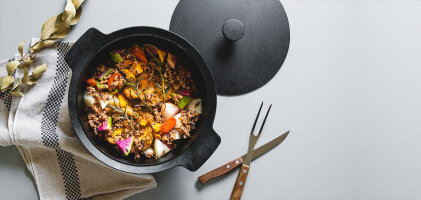Jingisukan - Grilled Lamb Japanese Style

Inhaltsverzeichnis
Jingisukan recipe recipeIn the late 19th century, the Japanese government promoted sheep farming as a source of wool. People were encouraged to eat mutton to become stronger. Occasionally, authorities organized events in Tokyo and Hokkaido where the meat could be tasted. By the 1930s, the dish began to gain familiarity and establish itself among the Japanese people. Jingisukan is still popular today, especially in Hokkaido, where sheep farming is still prevalent.
Special cast-iron pans are available in Japan for the Genghis Khan dish. The pans have a raised center where the meat is grilled and a rim that resembles the shape of a hat, allowing vegetables to cook in the meat juices. Many households in Hokkaido own such a special pan, giving the dish Jingisukan a unique place in Japanese cuisine.
Jingisukan - Recipe
 2 personsNo. of persons
2 personsNo. of persons
 ca. 45 minutesTotal Time
ca. 45 minutesTotal Time
 easyLevel of difficulty
easyLevel of difficulty
 main mealDish
main mealDish
 ca. 800kcal per portionCalories
ca. 800kcal per portionCalories
 Meat
Meat
 Lactose-free
Lactose-free
 Alcohol
Alcohol
 Kitchenware
Kitchenware

|
400g
thinly sliced lamb
|
|
1
large onion
|
|
2
green peppers
|
|
1/4
Cabbage
|
|
1/8
Pumpkin
|
|
Vegetable oil
|
|
1/3
onion - finely chopped
|
|
1/2
Apple - grated
|
|
1
clove of garlic - finely chopped
|
|
1 tsp
ginger - finely grated
|
|
7 tbsp
soy sauce
|
|
3 tbsp
sake
|
|
2 tbsp
sugar
|
|
Salt and pepper
|
|
Spring onions according to taste
|

Please note - this recipe is for 400 g of lamb; adjust quantities accordingly based on the amount of meat. For example, for 4-5 people, we recommend using 1.5-2 kg of lamb.















-from-the-yakiyaki-grill-pan.jpg)




